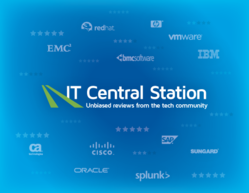New B2B social networking and community site
empowers real users to share unbiased opinions while maintaining their privacy.
New York, NY ,PRWEB
 Enterprises worldwide spend nearly $3 trillion
annually on technology products and services. The technology professionals who
spend this money base their decisions primarily on information from vendors,
consultants and analysts. However, what they really want is access to actual
users of the products and services to get unbiased opinions based on their real
world experience. IT Central Station enables technology users to speak out and
make their opinions heard while enabling technology buyers to tap into this
wealth of knowledge to make the best buying decision.
Enterprises worldwide spend nearly $3 trillion
annually on technology products and services. The technology professionals who
spend this money base their decisions primarily on information from vendors,
consultants and analysts. However, what they really want is access to actual
users of the products and services to get unbiased opinions based on their real
world experience. IT Central Station enables technology users to speak out and
make their opinions heard while enabling technology buyers to tap into this
wealth of knowledge to make the best buying decision.
IT Central Station was built for the needs of
enterprise technology users. Site features include:
·
Private social network for the end user community: Prevents
vendors from posting reviews of their products or competitor products.
·
Rigorous user validation: Validates the authenticity of users
based on their company email address and cross-references with LinkedIn and
other data sources.
·
User privacy: Promotes candid discussions and recommendations
within the community by enabling users to post anonymously.
·
Professional social graph: Uncovers a user’s professional
connections with expertise in products and services of interest.
·
Over 4,000 enterprise-class products and services from over 1,400
vendors: Includes the largest and most up-to-date catalog of technology
products and services—including cloud, SaaS, mobile and Big Data solutions—that
are used by enterprises.
“In my personal life I use online review sites
such as Yelp, TripAdvisor, and Angie’s List to help me choose what is best for
me,” said Russell Rothstein, co-founder and CEO of IT Central Station. “So I
was amazed to discover that enterprise technology professionals had no place to
go to get online product reviews and connect with real users before making such
an important purchase. That’s why we founded IT Central Station–to empower
enterprise buyers with access to information and connections they never had
before.”
The New B2B Technology Buying Process
The Internet is a disruptive force in the way
enterprises make buying decisions. “Tech buyers delay engaging with salespeople
until later in the purchase process, “ said Peter Burris VP Research Director,
Digital Products at Forrester Research Inc. “Our research shows that tech
buyers are using web and community resources to complete nearly 70% of their
buying journey before they ever engage with a sales resource.” (Source:
Catching Up To Tech Customer Communities, Forrester Research Inc., October 31,
2011). IT Central Station provides the most critical online resources
technology professionals need as they start and progress through their buying
journey.
Pricing and Revenue
Model
IT Central Station is 100% free for end users of
technology products. Revenue comes from vendors who sign up to connect with the
IT Central Station community of users and buyers. Vendors can gather candid
feedback from real users, invite their happy customers to share success stories
with the community, and participate in relevant discussions taking place within
a high quality community of real users. IT Central Station protects the privacy
of its users and has a 100% opt-in policy to prevent unwanted solicitations
from vendors.
IT Central Station is revolutionizing the
enterprise technology buying process through the power of online product
reviews and social networking. Enterprise technology professionals use IT
Central Station to access and share unbiased product information and tap into a
community of other real users in order to make the best buying decision in the
$3 trillion market worldwide for enterprise IT products and services.

















